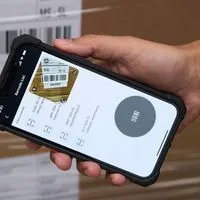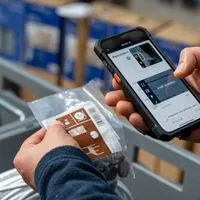How to Eliminate Inefficiencies with Smart Data Capture
| Products & Solutions
:format(jpeg))
Data is the lifeblood of any business, yet many struggle to capture, harness and exploit it effectively. Leaving data to lie dormant results in missed opportunities to improve efficiency and gain competitive advantage.
According to Accenture, on average, between 60% and 70% of all data within an enterprise goes unused for analytics. And in their words: “That’s unacceptable in an age where deeper, actionable insights, especially about customers, are a competitive necessity.”
On the other hand, research by IDC shows that businesses excellent at data intelligence perform substantially better than their peers. This holds true across many measures, including a 32% difference in revenue growth.
:format(jpeg))
Interestingly, organizations often fail at the very start of the data pipeline, with the process of capturing data. And any investment to improve other data processes is a poor one without the fundamental ability to collect and aggregate data effectively.
In this blog, we explore the pitfalls of poor data collection and, conversely, its true value to operational efficiency when harnessed correctly. There’s also concrete examples of how smart data capture (also known as intelligent data capture) eliminates inefficiencies in all walks of business.
The top 3 factors making data capture inefficient
Data capture is the process of collecting information from the physical world and turning it into a form a computer can use. Every time an employee does an inventory count, receives goods, or scans an ID, it’s a form of data capture.
However, the processes used to capture data are, all too often, outdated and inefficient. Frontline workers spend billions of hours every year in laborious tasks such as scanning thousands of individual barcodes a day, or manually checking off thousands of in-store prices and promotions against lists sent from head office.
:format(jpeg))
The three key factors driving inefficient data capture are:
1. Reliance on partly or wholly manual data capture methods
Manual processes have a far-reaching effect on many aspects of an organization, from quality control to scalability to the bottom line. They also adversely impact productivity and labor costs. Operationally, they increase the risk of errors, compromise the traceability of processes and cause employee attrition due to the tedious and time-consuming nature of data capture tasks.
2. Lack of real-time data access
Data is king but only when it’s readily available, in real-time. Unfortunately, data democratization has not yet made its way to the frontline.
Frontline workers spend billions of hours capturing data, for example when scanning stock items or parcels for sorting and delivery. But their data capture tools don’t return the favor by giving them access to useful, real-time insights at the moment they need it. And slowness to respond because of a lack of data leads to poor decision making, unsatisfactory customer engagement and employee friction.
3. Disconnected and siloed data capture workflows
Data capture is carried out in isolated pockets. This leaves end-to-end workflows disparate, inefficient, unintelligent and prone to error.
:format(jpeg))
How smart data capture eliminates inefficiencies
Smart data capture combines multiple data sources (barcodes, text, IDs and objects) and provides rich insights at the point of data collection. This enables real-time decision making and workflow automation at scale. For companies exploring new technology solutions, selecting the right barcode scanner is a crucial step toward ensuring seamless integration and performance.
Smart data capture can be integrated into any ecosystem to automate and future-proof operational processes. It can utilize any smart device with a camera as a data capture tool, including smartphones, tablets, drones, robots and wearables as well as specialist data capture devices such as handheld scanners.

What is smart data capture?
Smart data capture empowers businesses to capture and access real-time data using any smart device with a camera. It can be deployed into any ecosystem.
The impact of smart data capture on operational efficiency is profound:
Automated workflows increase productivity and improve resilience
Smart data capture streamlines and accelerates business processes, delivering consistent, reliable and high-quality outcomes. By shifting tedious, labor-intensive and error-prone manual tasks to automated technology, valuable human resources can be redirected to projects that benefit from human skills, knowledge and problem-solving.
Smart data capture enables smart, efficient decisions on the ground
Smart data capture is true data democratization, making real-time data and actionable insights transparent and accessible to every level of the organization. One of the biggest trends in data capture today, this is changing data capture from a one-way data collection task to a two-way process, streaming back near-real-time visibility and actionable insights.
:format(jpeg))
It enables fast, distributed real-time decision making and swift, accurate responses to emerging problems during periods of disruption.
Better data capture experiences attract and retain workers
A lot has changed in the labor market. Staff shortages, a millennial and Gen Z workforce and a transient gig economy are all changing employee expectations. And dissatisfied workers lead to inefficiency through process drag and resources wasted on repeated recruitment and training programs.
:format(jpeg))
46% of workers value the right technological tools to make their jobs easier, according to Microsoft. And that’s not surprising, given that in our personal lives we’re all used to having a supercomputer in our pocket and access to data at our fingertips.
Smart data capture improves employee experience by modernizing data capture. It reduces the amount of time spent on tedious, repetitive work, freeing up employees to do more valuable and rewarding tasks such as engaging with customers.
Not only that, but employees’ smart data capture solutions provide instant access to real-time data (on, for example, stock levels or alternative products) that enable them to excel at tasks such as customer service.
Total cost of ownership falls
Smart data capture enables the consolidation of devices to fulfil multiple tasks.
Instead of carrying several single-use devices for communication, document verification and tracking, fewer devices – or even a single device – can handle multiple operational tasks. This improves efficiency by cutting costs and maximizing existing technology.
Reducing inefficiency can extend even further with strategies such as bring your own device (BYOD). Here, employees are approved to bring and use their personally-owned device for work.
:format(jpeg))
Scalability and flexibility increases
Unpredictable peaks in demand are all too common nowadays.
Being able to scale services at speed without sacrificing quality is a key priority. This is particularly true when you consider customers’ increasing expectations, (for example, in delivery and logistics).
Because smart data capture integration is simple on ubiquitous smart devices, fast capacity scaling is easy. There’s no downtime or disruption. The familiar nature of devices and intuitive interfaces also improves efficiency in onboarding and training. Employees can set to work almost immediately with a tool that can switch flexibly between tasks.
Businesses remain future ready, whatever demands lie ahead.
How smart data capture eliminates inefficiencies across industries
Smart data capture enables real-time decision making, employee and customer engagement and workflow automation at scale across industries.
Unlike the old way of data capture, it isn’t quantified by a simplistic measure of items counted over time. Instead, it’s measured by exponential productivity gains, richer business insights, increased employee satisfaction, enhanced customer loyalty and ultimately profit and revenue growth.
Eliminating inefficiency in retail
Smart data capture digitizes, simplifies, speeds up and automates retail workflows such as stock taking, shelf management, order picking and mPoS. It enables multiple tasks to be handled by the same store associate on the same device.
For example, UK fashion retailer River Island improved both efficiency and customer experience by empowering their employees across 300+ stores with smart data capture. Armed with a mobile device, store associates can now easily do multiple operational tasks and advise customers with real-time stock and price information. This delivers a hyper-personalized mPOS service.
:format(jpeg))
Eliminating inefficiency in delivery and logistics
More efficient and accurate data capture expedites freight flow and establishes compliant audit trails.
Mobile apps enabled with smart data capture empower drivers to complete delivery tasks with greater speed and accuracy from depot to doorstep. Augmented reality overlays, for example, instantly show the driver exactly which parcel they need to take out of the back of the van for a delivery. Age verification for restricted goods can also be automated on the same smart device.
Meanwhile, customer experience is improved at PUDO parcel shops with higher speed and accuracy in retrieving parcels and recording pickups or drop offs.
:format(jpeg))
Eliminating inefficiency in air travel
Smart data capture on mobile devices reduces inefficiency in critical ground handling operations.
Baggage can be tracked and rerouted easily through the airport and lost items located more easily, saving time and mitigating the risk of passenger friction.
Moving passenger check-in and flight boarding away from fixed podiums with boarding gate readers also reduces waiting time. When Scandinavian Airlines moved to a single mobile app for scanning passports, boarding passes, luggage tags and meal vouchers both customer and employee experiences improved.
It also typically reduces the total cost of ownership by 35%-50%.
:format(jpeg))
Eliminating inefficiency in healthcare
By tracking assets and gathering information using smart data capture on handheld devices, hospitals can improve efficiency, workflow management and compliance.
For example, a healthcare professional can scan a barcode on a patient’s wristband, on medication or on donated blood and immediately take relevant action.
:format(jpeg))
Actionable intelligence to reduce operational inefficiencies
There are so many missed opportunities to improve operational efficiencies due to ineffective data capture.
Yet, it doesn’t have to be that way – in any business. Smart data capture empowers workers with actionable intelligence, increases productivity, reduces cost and ensures businesses are future ready.
Smart data capture solutions are here, they’re accessible and ready to go.

How smart data capture works
Discover how smart data capture delivers superior customer experiences and business outcomes.